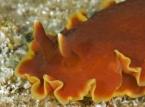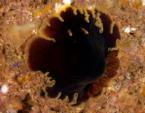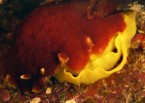| Home |
| Acknowledgments |
| Conventions |
| Glossary |
| Maps |
| References |
| Links |
| Articles |
| Thumbnails |
| Species
list |
| Family |
| Next
species |
Additional Photos

side

top

rhinophores

pale brown, blotchy

dark

translucent

with egg mass
_______________
GALLERY

Dendrodoris sp. #1

| Maximum size: about 76 mm. Identification: This species is opaque brick-red with yellow-white margins on the mantle and foot. The rhinophores are tipped in white and the branchia are cream with a brick-red rachis. The branchia are intermediate in size between those of Dendrodoris fumata and Dendrodoris nigra while the rhinophore clubs are longer with roughly twice as many lamellae. It may also be distinguished from those species by its habit of holding the mantle margin in three or four deep, narrow folds (more in unusually large animals) rather than several shallow, broad folds. Occasionally, the notum may have faint darker mottling and, rarely, it may be light or dark brown (while retaining the other features that distinguish it from D. fumata). Natural history: Dendrodoris sp. #1 is a moderately rare species found in moderately exposed rocky habitats at depths of 4-15 m (13-50 ft). Unlike most Dendrodoris spp., it can sometimes be seen in the open during the day (based on reports by John Hoover, Dennis McCrea and Bill Stohler). Sue Kellam photographed one in association with a yellow spiral egg mass. Distribution: Big Island, Maui, Lanai, Oahu and Kauai: also known from Kwajalein Atoll, the Philippines, Christmas Island (Indian Ocean) and Reunion. Taxonomic notes: This species is listed as Dendrodoris rubra in Hoover 1998 & 2006 (corrected in 5th printing). It was first recorded in Hawaii at Honaunau, Big Island by Scott Johnson on May 18, 1978. It's referred to as the "red dendrodoris" in Hoover, 1998 & 2006. It was listed as Dendrodoris rubra on some sites until the type specimen of D. rubra was found to be a D. fumata. Photo: Dennis McCrea: about 76 mm: off Old Kona Airport, Big Island; June 5, 2009. Observations and comments: Note 1: ( ) |
| Thumbnails |
Species
list |
Family | Next species | Top |